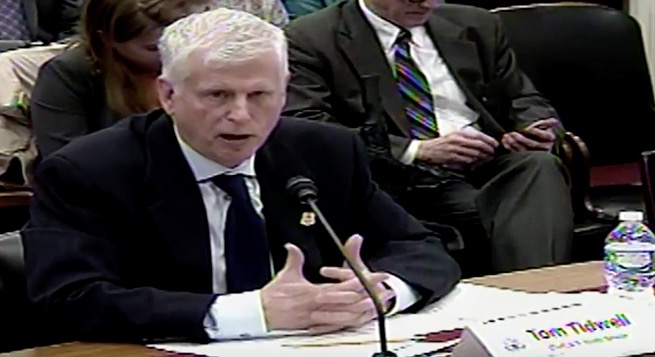On Wednesday Tom Tidwell, Chief of the U.S. Forest Service, testified before the House Committee on Appropriations’ subcommittee, the Interior, Environment, and Related Agencies Subcommittee. The primary objective of the hearing was to discuss the budget for next year, Fiscal 2017. The text of the Chief’s prepared testimony is here, wherein he outlines some broad points about budget trends that the administration expects. Of course if or when Congress approves a budget the final version could be very different.
During the hearing there were naturally many questions from the representatives about the budget, but there were also discussions about grazing fees, transferring federal land to the states or other entities (spoiler alert, Chief Tidwell is opposed), initial attack of fires, the safety of using C-130 air tankers, and two representatives encouraged the Forest Service to take advantage of drone technology to provide real time intelligence about ongoing wildfires.
Below are some excerpts from Chief Tidwell’s prepared testimony about the administration’s budget proposal for FY 2017:
- Collaborative Forest Landscape Restoration Program ($40 million, the same level as the FY 2016 enacted level)—to continue the 23 existing projects, which reduce the risk of catastrophic wildfires in high-priority, high-risk areas; improve water quality and quantity; increase carbon sequestration; and build on innovative implementation and monitoring work with our partners. In addition, we propose increasing the authorized funding level for this program from $40 million to $80 million for future years.
- Suppression ($873.9 million, an increase of $62.9 million above the FY 2016 enacted level)—this amount represents 70 percent of the 10-year average costs for fire suppression, currently calculated at $1.248 billion. The proposed cap adjustment would cover the remaining 30 percent of the 10-year average suppression costs as well as any costs currently funded through fire transfers. For FY 2017, the proposed fire suppression cap adjustment is $864 million.
- Hazardous Fuels ($384.1 million, an increase of $9.1 million above the FY 2016 enacted level)—to focus on fuels treatments in the wildland/urban interface to reduce the risk of catastrophic fire on 1.8 million acres.
- Landscape Scale Restoration ($23.5 million, an increase of $9.5 million above the FY 2016 enacted level)—this increase will fund approximately 20 more innovative, cross-boundary projects that target high-priority areas identified in the States’ forest action plans. This continued investment in cross-boundary, landscape-scale projects on State and private lands will spur innovation, bring partners to the table, support climate change mitigation and adaptation, and allow the agency to leverage partner contributions. We will maintain strong collaboration with our State partners to develop solutions to complex problems.
- Law Enforcement and Investigations ($131.6 million, an increase of $5 million above the FY 2016 enacted level)—the funds will support intensive operations at marijuana plantations on the national forests and a comprehensive eradication, dismantling, and reclamation strategy. The additional resources will pay for removing infrastructure, trash, debris, and hazardous materials (such as rodenticides and herbicides) at the plantations and for reclaiming old marijuana sites.
- Facilities ($71.6 million, a slight increase from the FY 2016 enacted level)—to maintain our developed recreation sites and our fire, administrative, and other facilities.
- Legislative Proposal: Fire Suppression Cap Adjustment. We propose a budget cap adjustment to fund suppression costs for large and complex fires. Suppression would be funded at a level that covers 98 percent of the fires we fight, or 70 percent of our 10-year average suppression costs. Remaining fire costs would be funded through an “off-budget” fire suppression cap adjustment. This proposal provides a long-term solution to address the critical and growing problem of paying for catastrophic wildfire versus annually enacted funding solutions. While the latter may help avoid disruptive mid-season transfers, it introduces a large amount of uncertainty about consistent funding levels needed to maintain a meaningful program of work.


So just when this hearing gets really interesting between Congressman Mark Amodei (R NV) and the Chief (approx. 1:05:00) it abruptly skips forward.
(Groan)